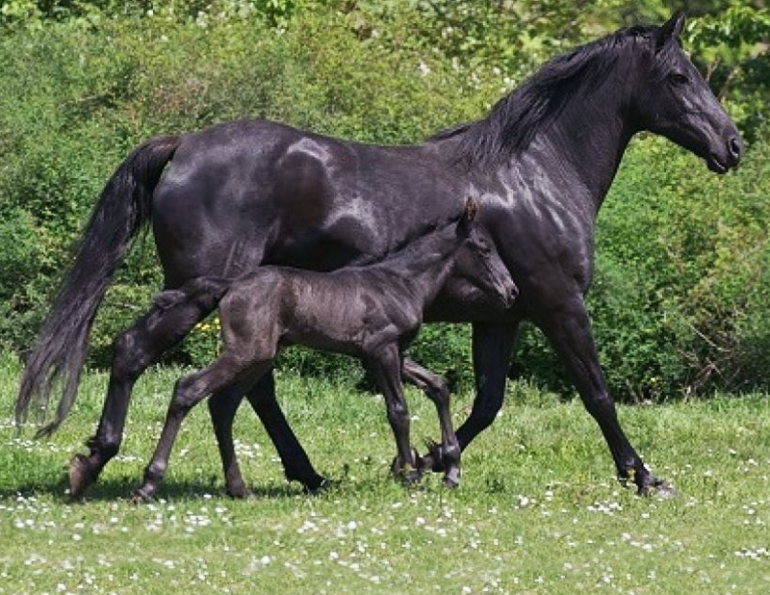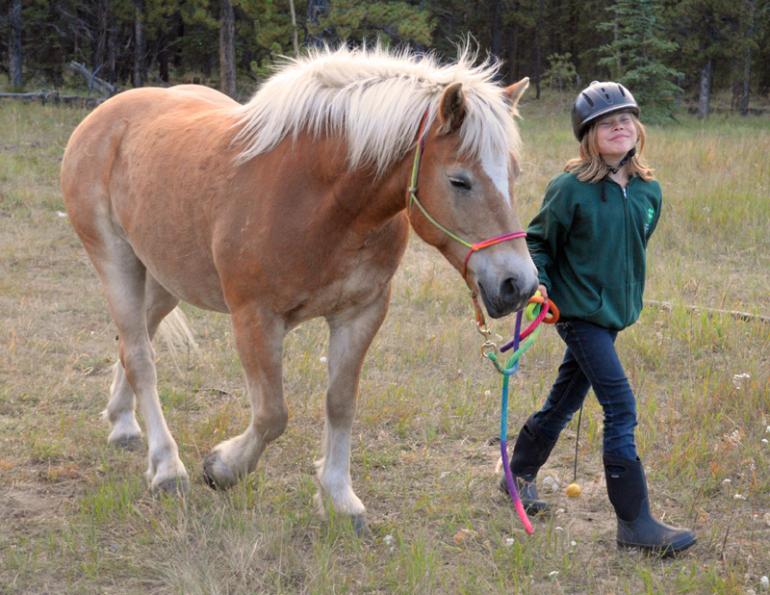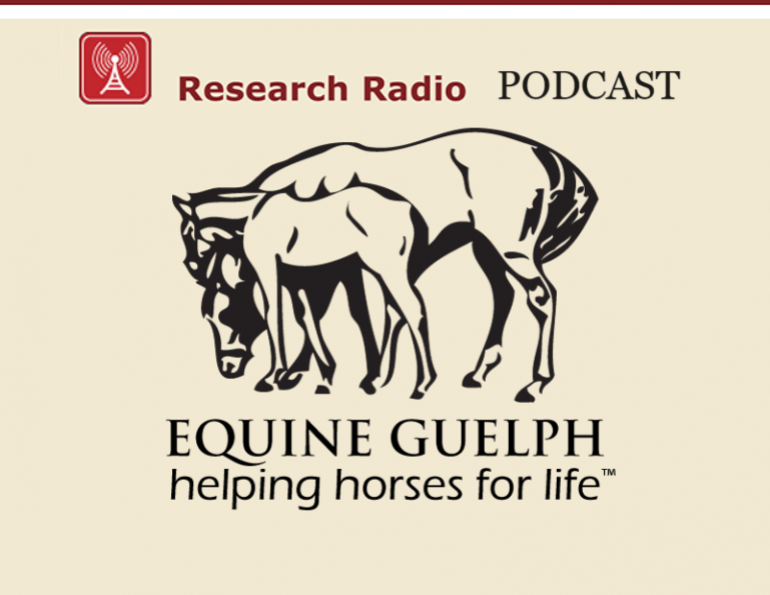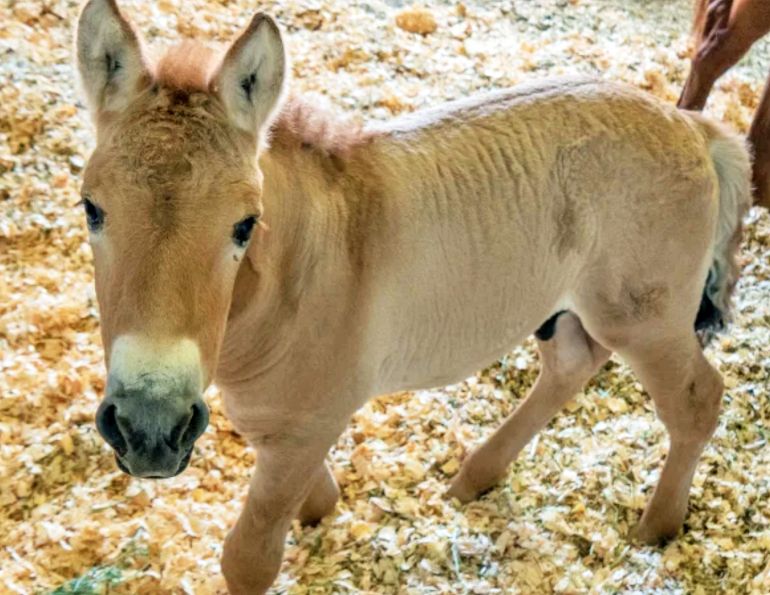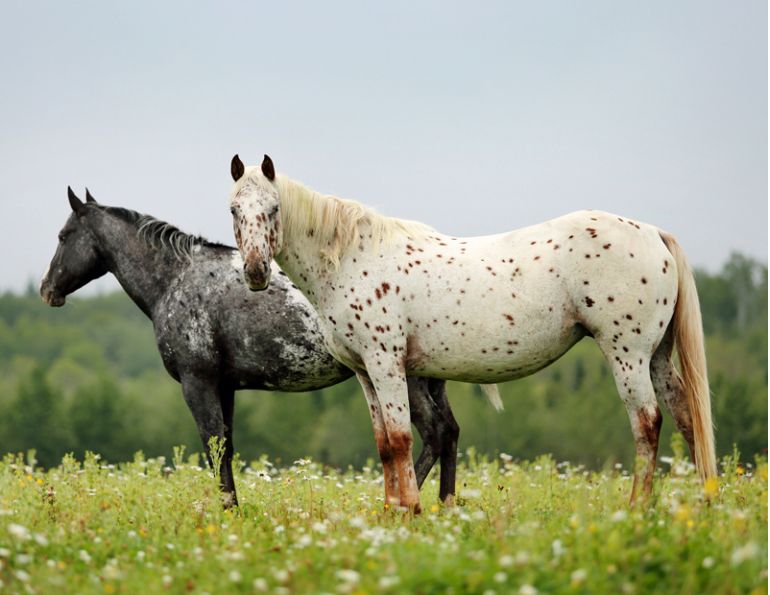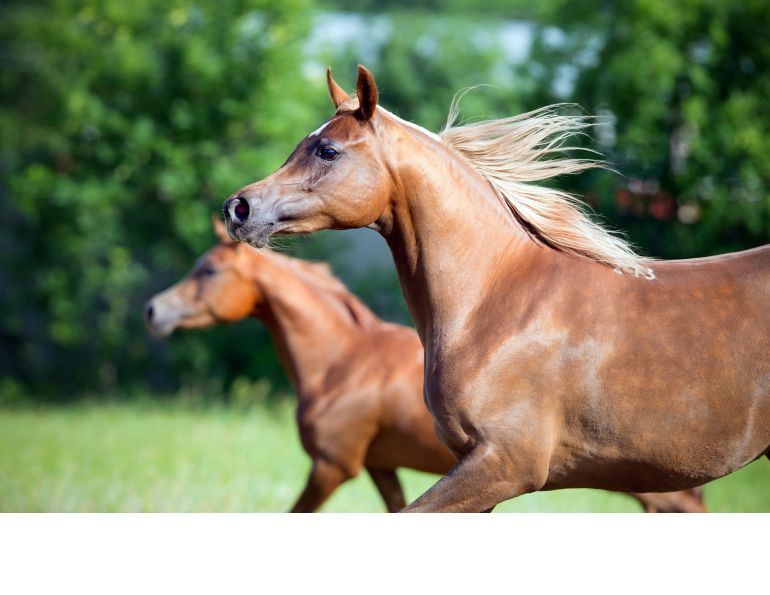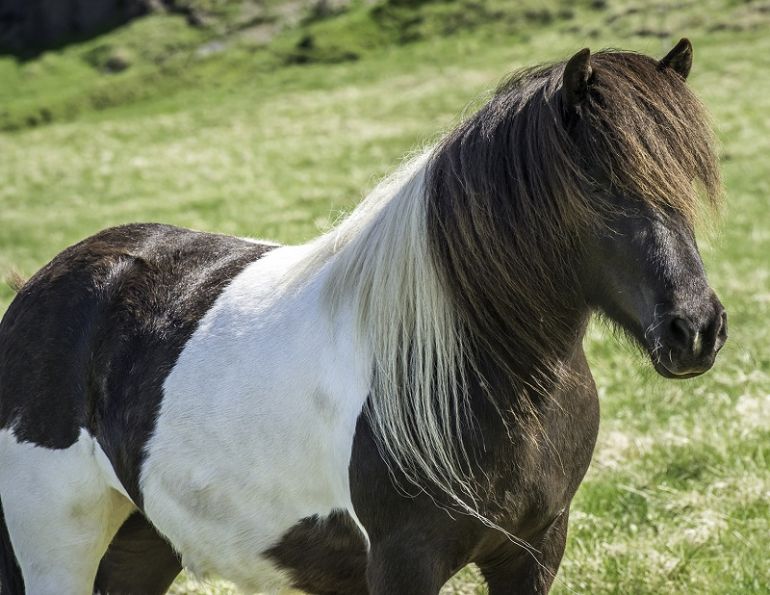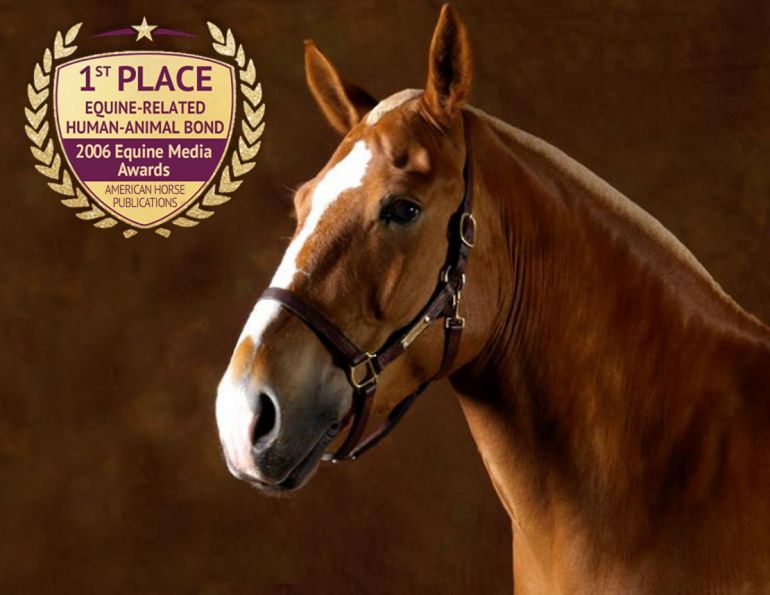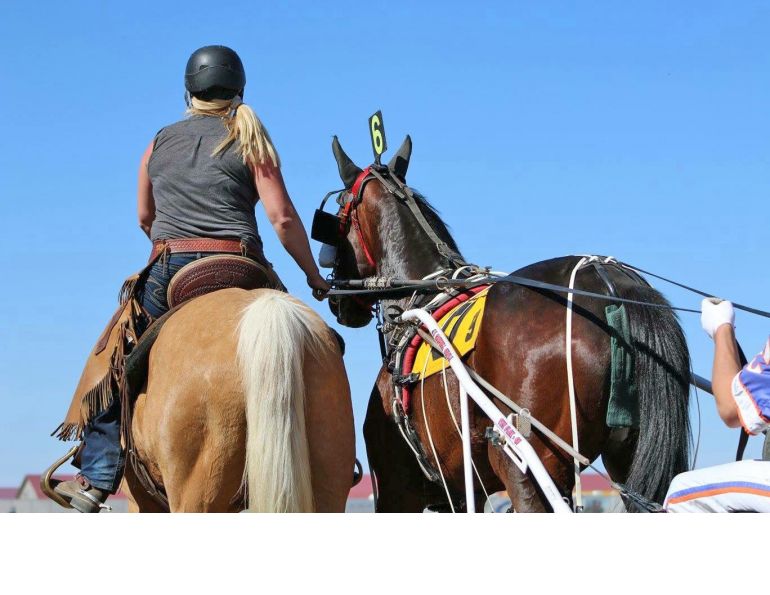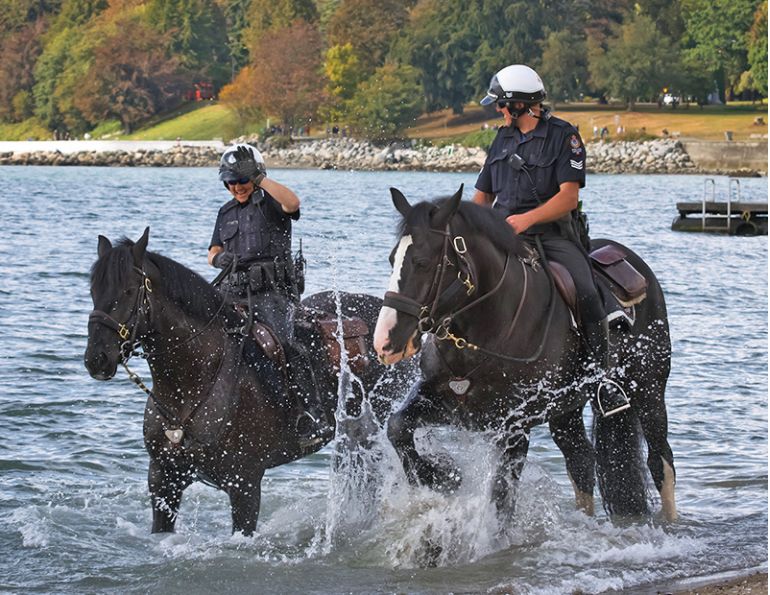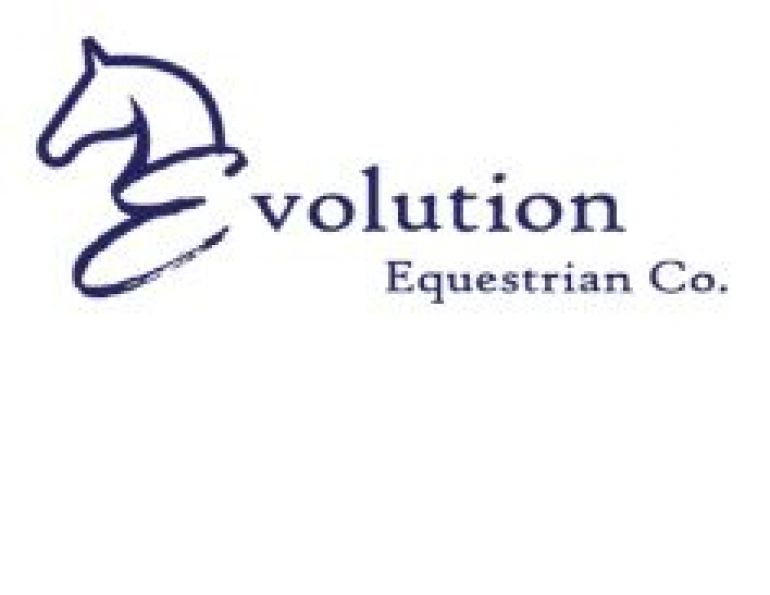A Treasure for Over 350 Years
By Margaret Evans
Good things were happening in New France in 1665.
The New World colony had been under the tight control of the Company of One Hundred Associates since 1627. It capitalized on the fur trade while expanding French colonies along the Gulf of the St. Laurence and the river valley. But they were sporadically under siege from either native Iroquois tribes disrupting the fur trade, turf wars with the British, or conflicts with Quebec settlers resenting the company’s monopoly on trade.
With their future constantly threatened, the company finally surrendered its charter. In 1663, Louis XIV made the resource-rich New France a royal province giving it the security that stimulated emigration to the far-flung colony.

Above and below: In 1665, King Louis XIV of France sent two stallions and twelve mares to New France, a newly established colony along the St. Lawrence River, which at the time had a complete absence of horses. One of the first communities in New France to welcome the horses from the King’s Royal Stables was the Congregation de Notre-Dame on the present-day site of the Maison Saint-Gabriel Museum Historic Site in Montreal. Pictured are the former farmhouse and the stone barn, which dates from the 1820s, where descendants of the horses were housed. Photos: Maison Saint-Gabriel/Pierre Guzzo.
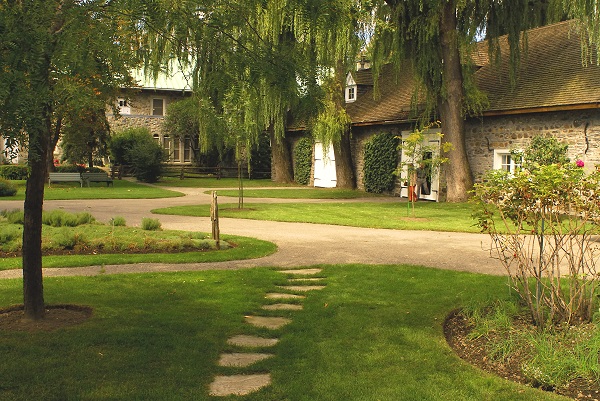
Those willing to make the move had their travel paid for, especially single women 15 to 30 years of age and sometimes known as the King’s Daughters or the King’s Wards, since they were under guardianship. With marriages, the population of the colony rapidly began to grow.
According to the website of Maison Saint-Gabriel Museum and Historic Site in Montreal, when Louis XIV ordered the creation of a royal horse stud in each of his provinces, New France was an anomaly because of the complete absence of horses in the territory. He quickly fixed that.
In 1665, the King not only sent a French infantry garrison, the Carignan-Salières Regiment, to shore up security, but along with shipments of settlers and soldiers went two stallions and twenty mares selected from the King’s Royal Stables where up to 700 fine saddle horses were kept. The King was no slouch when it came to prized horses and he was an expert horseman.
The rough voyage, though, resulted in eight mares perishing but on July 16, 1665, the stallions and the 12 remaining mares stepped onto Canadian soil to begin a legacy that, in 2015, celebrated the 350th anniversary of the Canadian horse.
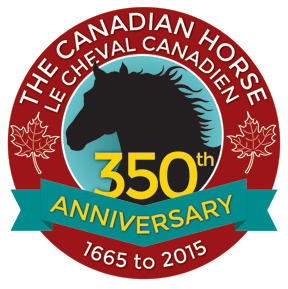
Shipments continued and between 1665 and 1671, some 82 horses arrived in New France from the Royal Stables. Those horses most likely originated from native herds in France (Normandy, Brittany, and the historical province of Poitou) and Spain (Andalusia), regions renowned for the quality of their horses since before the Middle Ages.
Related: The American Quarter Horse
The book The Horse and His Diseases by veterinarian Robert Jennings, published in 1861, described the Canadian as having “ears wide apart and not unfrequently a basin face, the latter, perhaps, a trace of the far remote Spanish blood said to exist in his veins.”
The first horses to arrive in New France were allocated to religious communities and to gentlemen with a keen interest in farming. One of the first communities to welcome the horses was the Congregation de Notre-Dame on the present-day site of Maison Saint-Gabriel, which provided a home for the King’s Daughters. The magnificent stone house was built around 1661 and, in 1668, was bought by Marguerite Bourgeoys, who had founded the Congregation de Notre-Dame. There was a barn and several stables made of wood before the construction of the stone barn in the 1820s. Bourgeoys and her colleagues used horses on the farm to grow food for the people in Montreal during the 1670s and they owned five of the horses in the city.
Under contract, individual farmers and religious communities were to care for the horses, breed them, and donate a foal to the administration under Intendant Jean Talon within three years. During that time the King continued to own the horses. Foals were then redistributed under the same conditions. The breeding system worked and the population rapidly grew to over 13,000 in the 18th century.
The Quebec-based horses proved to be very tough. They adapted to the climate and geographical conditions, much of which was extremely challenging. They could accomplish any task put before them, and developed an enviable reputation as the “little iron horse” that Americans and later the English (after France formerly ceded the territory to Britain in the Treaty of Paris in 1763) came to love and admire.
Today, as then, the Canadian is a sound horse with solid feet and legs, broad chest, strong shoulders, arched neck, short back with well-muscled hindquarters, and varying in height from 14.2 to 16 hands or taller. Colours are generally black with some bays, chestnuts, and white markings. Their hallmark features are thick, lush, wavy manes and tails. They are easy keepers, good-natured, and willing to please under any condition. And they are extremely intelligent and quick to learn.

Above and below: An inquisitive 2015 Canadian colt frolics at Dan Wilson’s Woodmont Canadians in Ladysmith, BC. Wilson was instrumental in having the Canadian horse declared Canada’s National Horse in 2002. He believes the Canadian horse will survive as it is a bold symbol of Canada’s national pride. Photos: Jill Livesey
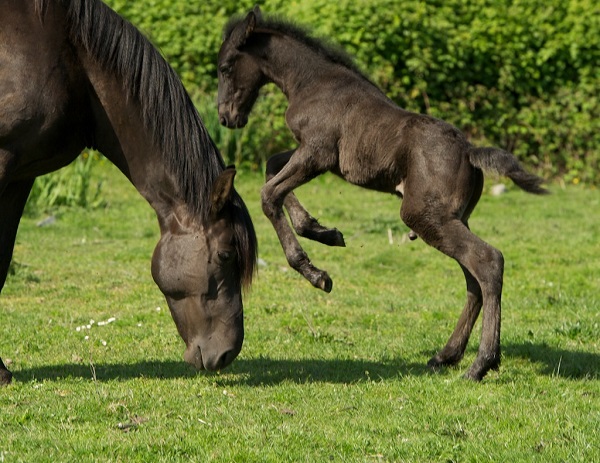
“They are an ‘all round’ horse suitable for the majority of horse owners as opposed to being an elite equine athlete that only an expert can ride,” says Yvonne Hillsden of Cherry Creek Canadians in Kamloops, British Columbia. “They can easily switch roles, be it from a combined driving horse, to a trail horse, to one that pops around a small course of jumps, to being the kids lead-line pony. Very few other breeds have the nature, amenable temperament, good minds, willingness to please, and flexibility to do this with such ease.”
That description of versatility was echoed by Kelly Twordik of Ebony Breeze Farm on Vancouver Island, who views the Canadian as an amazing all-around horse that is people and child friendly, adjusts easily to their surroundings, and is not moved by machinery, traffic, or loud noises, which is why they can make a good police patrol horse.
“My Canadian, Pennylane, helped babysit my eight-year-old daughter in a breed show when she rode English and Western,” says Twordik. “The horse would move its body over and catch my daughter’s seat so she stayed balanced in the saddle. It was so amazing and smooth that my daughter won the judge’s choice award by Dorothy Kirby. My daughter is a good rider but it was an amazing example of the relationship between horse and rider and how the horse looked after the rider as well.”
Steve Lemon, director-at-large with the Canadian Horse Association Rocky Mountain District, sees the breed as a stout, sturdy, versatile driving and saddle horse.
“They have personality plus, a powerful constitution, and a straightforward attitude to work,” he says. “I’m convinced that to make progress with a Canadian, you have to make a solid, honest connection and win their heart. Then there are no limits to your work together.”
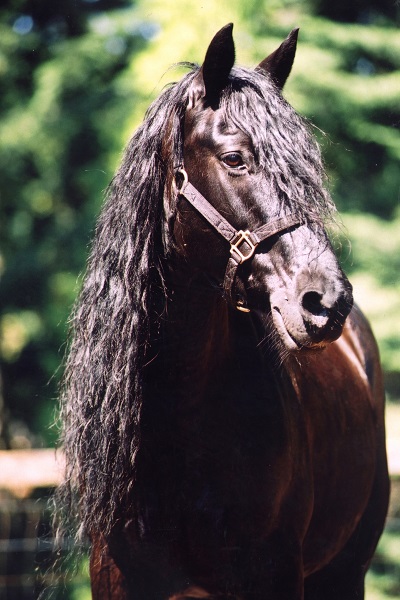
Above and below: Wendy, a beautiful Canadian mare, and the broodmare band in an idyllic setting at Woodmont Canadians in Ladysmith, BC. Photos: Robin Duncan Photography
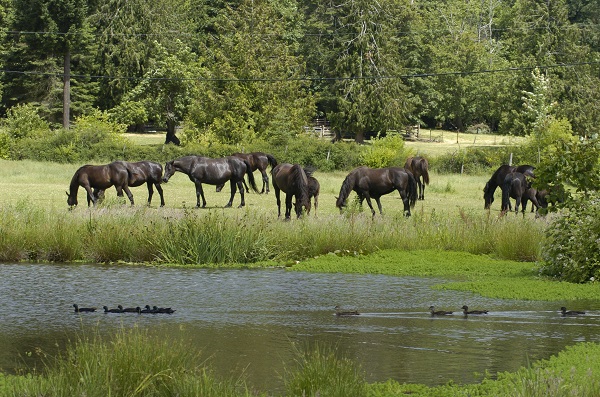
Breeder Ray Lalonde of Beckett’s Creek Farms in Cumberland, Ontario, echoes that statement. To him, the breed is like no other and he praises them as smart, intelligent, hardy, and great survivors.
“As a teenager I used to help my dad in the bush doing some logging,” says Lalonde. “My dad would be cutting trees in a gully away from the top of the hill. He would tie a log on our Canadian gelding and send him up to the skidway on top of the hill. Upon his arrival we would untie the log and return him back to my dad. This would go on all day.”
Across the centuries, the Canadian horse has played a critical role in the economic and social development of Canada as agriculture, transportation, and trades expanded to open up land further west. And they took part in wars, notably the American Civil War, Boer War, and World War 1.
Many Canadian horses went to the United States, where they became foundation stock for Morgan, Standardbred, and American Saddlebred breeds. Breeders would use Canadian horses to improve their own stock with quality bloodlines.
“The role that horses played in the years in the fur trade on the prairies and the Pacific Northwest is less widely known,” says Roxanne Salinas in her article The Canadian Horse in BC. “Horses became essential for the transport of supplies over the brigade trails from depots such as Fort Vancouver (Washington) to outlying northern posts, and for carrying the bales of fur back to the depots for shipment to the old country. In writing of the northwest brigades, fur trade historian, O.O. Winthrop reported ‘The number in a brigade could vary anywhere from about fifty to four hundred, and there were usually as many horses as there were people.’ In order to ensure a steady supply of horses, the Hudson’s Bay Company brought herds of horses into BC and established horse breeding operations at some of its forts, one of the largest being in Kamloops.”
Displaying the breed’s versatility, this Canadian is competing at Battle of the Breeds at Spruce Meadows. Photo: Robin Duncan Photography
The presence of the Canadian horse in British Columbia’s early history is all the more fascinating given the recently released report on the genetic heritage of the wild and isolated Brittany Triangle herd in the Cariboo.
For many years there has been widespread belief that the common ancestral lineage of wild horse herds in North America came from Spanish horses brought by the explorers in the early 16th century. That assumption also applied to some 1,000 horses in the remote Chilcotin plateau and the subpopulation of about 150 to 215 wild horses in the Brittany Triangle (?Elegesi Qayus Nemaiah Wild Horse Preserve) that are managed by the Xeni Gwet’in, a tribal group of the Tsilhqot’in First Nation.
But a preliminary genetic study by Dr. E. Gus Cothran, clinical professor, Department of Veterinary Integrative Biosciences at the Texas A&M University, has yielded surprising results documented in his report coauthored with Wayne McCrory with McCrory Wildlife Services in Denver, BC, for the Valhalla Wilderness Society and Friends of Nemaiah Valley.

Above and below: The 2002 Canadian stallion, Cherry Creek Fonzie Merit, stands at stud at Cherry Creek Canadians in Kamloops, BC. Owner Yvonne Hillsden describes him as a “beautiful, athletic stallion, with a very kind, amenable nature.” Photos: Yvonne Hillsden, Cherry Creek Canadians

In 2003 and 2004, eight blood samples had been collected from domestic ranch horses that had run wild in the Brittany Triangle. There was some indication of possibly old Spanish ancestry. Then between 2006 and 2010, 99 viable hair samples were collected from wild horses brushing by trees over a broad area where they travelled and sheltered. Given that the horses had been virtually isolated for several centuries because of mountain ranges and natural river barriers, tests were done for genetic uniqueness based on mitochondrial DNA sequence variation.
The tests revealed three distinct haplotypes. Comparisons were made with 69 different domestic horse breeds. The Brittany Triangle horse paired with the Canadian horse within the cluster that included the Shire, Clydesdale, Highland pony, Fell pony, Dales pony, and the Eriskay pony. The origins of the Brittany Triangle horse, though, are largely heavy horse types and the conclusion was that the Canadian horse breed or its ancestors contributed significantly to the ancestry of the Brittany Triangle horse.
Related: For the Love of Alberta's Wild Horses
Even more intriguing, the genetic study also revealed that the Yakut horse, an ancient breed of Russian origin that thrives in Siberia, also contributed to the origin of the Brittany Triangle herd. How could this be? There are no known connections between horses of BC’s Interior Plateau and those that may have existed in historic Russian America (Alaska). Clearly, more studies are needed.

Above and below: Youngsters at Cherry Creek Canadians. As many Canadian mares are being lost to the breeding pool, Yvonne Hillsden encourages Canadian mare owners to consider breeding their mares at least once or twice to the highest quality Canadian stallion available. Photos: Yvonne Hillsden, Cherry Creek Canadians

The popularity of the Canadian horse was like no other as settlement expanded across North America and agriculture, commerce, and trade exploded. So many horses were exported to the United States that by 1880 the breed’s population was plummeting in Canada. According to the Livestock Conservancy, in 1886 a small group of breeders in Quebec began a studbook and in 1895 the Canadian Horse Breeders Association was formed. Both the federal government and the Quebec provincial government maintained breeding programs but faltered, and in 1976 fewer than 400 horses remained. The breed society revitalized and numbers increased to a relatively healthy population. Then its profile was enhanced when, in 1999, the province of Quebec recognized the Canadian horse as an agriculture heritage breed, and in April 2002 it was declared the National Breed of Canada thanks to the diligence of Lalonde and Dan Wilson of Woodmont Canadians in Ladysmith, BC. The Quebec provincial legislature further officially recognized the breed as a “Heritage Breed of Quebec” in November 2010.
But in recent years, troubling statistics are once more threatening the breed in Canada.
“Since 2008, yearly registrations have been drastically declining to the point where the breed is currently hovering at 200 or less registrations per year,” says Hillsden. “This number is the cut-off point which has prompted conservation groups such as the Livestock Conservancy and Rare Breeds Canada to move the Canadian from its prior ‘threatened’ status to ‘critical.’ With registration numbers this low, the breed is simply not sustainable as there are not enough new individuals being born to replace those being lost.”
Hillsden says that reports put the reproducing population at an estimated 2,000 to 2,500. How can this be, some ask, when it seems that there are more Canadian horses than that around and the registry shows at least 1,000 more horses in existence? Many horses are aged and past their reproductive years, likely deceased but their passing not reported to the Registry, or in homes where owners have no breeding plans.

Above and below: Kelly Twordik describes her 12-year-old mare Pennylane of Ebony Breeze Farm in Victoria, BC, as, “a rare blue black horse, a true Canadian type out of Quebec a few lines back. The mare produces for the Calgary police and won Supreme Canadian Champion a couple years ago at the July 1st Breed show in Cowichan, BC.” Photos by Equine Photography
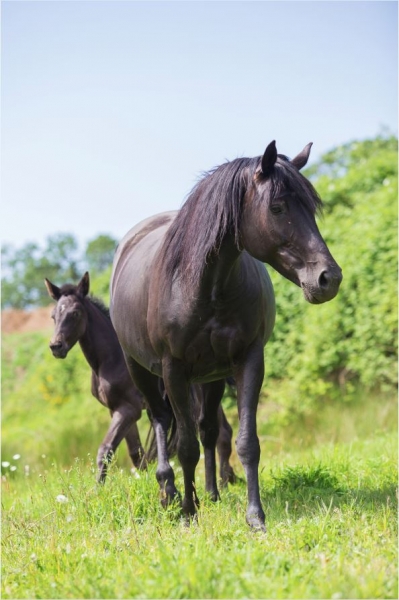
Since 2008, there has been a shift in ownership. There used to be a mix of owners and breeders, but in the last seven years many breeding operations have gone, victims of the economy and the rising cost of raising horses in a poor sales market. Now, instead of those horses being owned by breeders, they are owned by riders uncommitted to breeding.
“To put this in context, there are currently just over 3,000 mares 20 years of age and younger left in the breed,” says Hillsden. “Of these, probably at least 1,000 are too old or too young for breeding. Recent surveys of horse ownership in Quebec and BC indicate that nearly 50 percent of all mares owned are in homes where they are used as the primary riding horse with no plans to breed them. This means that the entire breeding population of mares may be much less than the 2,000 initially estimated. A more realistic number may be only 1,000 or so potential breeding mares remaining to contribute to the breed.”
All this, she says, coincides with declining stallion ownership. Prior to 2008, there were between 20 and 30 Canadian stallions standing in BC. A recent survey showed there are now only about 10 stallions left in the province that are currently breeding. Many are located in remote areas of the province and do not offer shipped semen so these stallions are not easily accessible to the majority of mare owners. In BC there may only be three or four stallions centrally located that offer comprehensive breeding services, making them readily available to mare owners.
“This situation is echoed in each Canadian province,” she says.
There is no question that the breed is in serious trouble.
Victoria Tollman, Executive Director of the Equus Survival Trust, very eloquently summed up the situation. She says, “Every worthy mare should be in purebred production and contribute at least two foals (or more if you can support that) back to the gene pool. Every mare should also have a good daughter to replace her in the breeding program when the mare is retired. Still, each person’s situation is their own, and they must act accordingly. Only you know what you can support. And if you can’t support any [foals] during the breeding life of your horses, I suggest you lease them out, trade them for a gelding or a senior Canadian in need of a retirement home, or sell or gift them to breeders who can. You owe that to your breed. So, no, it’s not easy being a rare breed steward. The sacrifices are many. The challenges tough. The rewards? Priceless…”.”
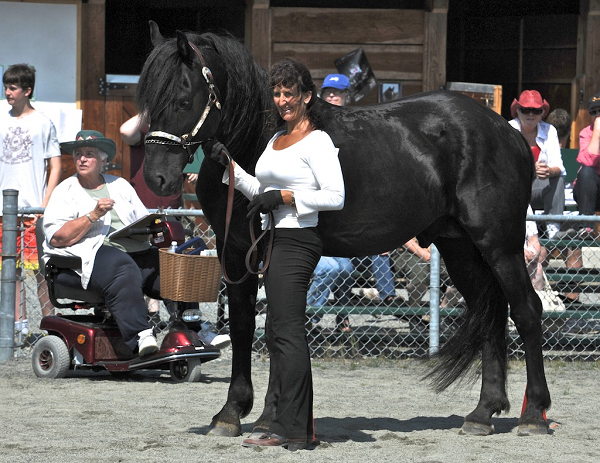
Guinness, a 16.1 hand Canadian stallion, stands at stud at Ebony Breeze Farm in Victoria, BC. Photo courtesy of Kelly Twordik
Hillsden urges everyone concerned about the breed’s preservation to encourage Canadian mare owners to seriously consider Tollman’s suggestions. “To ensure that the breed continues and that every mare’s genes contribute to the gene pool we hope that all mare owners will consider breeding their mares at least once or twice. In order to best contribute to the breed, choose the highest quality stallion possible, and which best compliments the mare. In order to make the breeding count, it’s not enough to choose a stallion based on convenience or the most affordable stud fee. Be open to using shipped cooled or frozen semen to achieve this. Register your foals after they are born, and especially before they are sold.”
Lemon is on board with this whole concept. “The future of the breed will be the responsibility of dedicated breeders keeping them as they were and not making a contemporary sport horse. I will be breeding this season. My objective is a 14 hand sturdy driving pony using the ‘little iron horse’ as my guide.”
Lalonde sees the drop in number of registered foals as systemic across the horse industry. “Most breeds have gone down in number of newborns by 50 percent,” he says. “Parents can’t afford to buy a horse for their kids, the parents can’t afford the boarding, upkeep, and the cost of lessons. According to studies in the US, this downward trend should change in around 2020.”
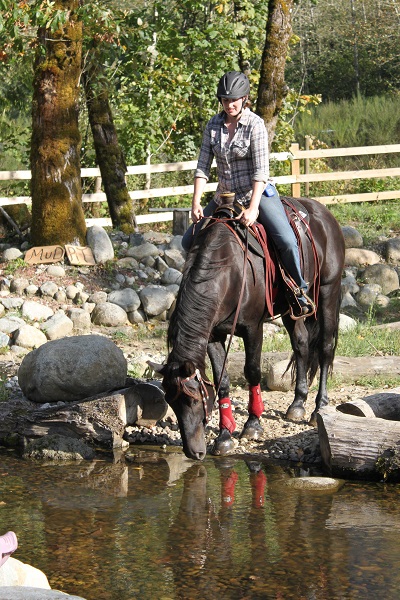
Above and below: Jasper, a 6-year-old, 15.3 hand Canadian gelding owned by Aynsley Cairns, displays the willing, sensible temperament that makes spending time with a Canadian horse so rewarding. Photo (above): Michelle Gazely, Photo (below): Aynsley Cairns.
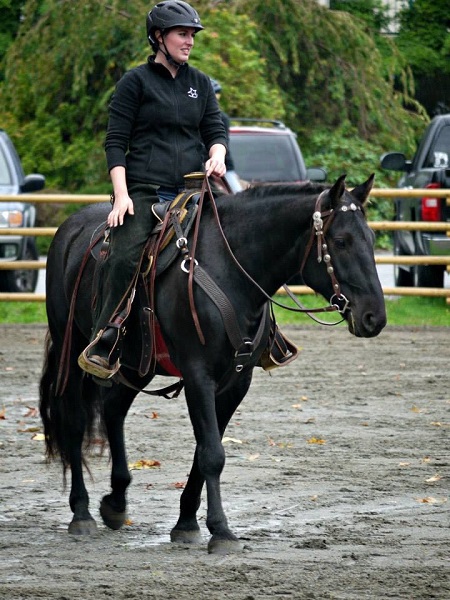
“The Canadian horse is in a very dangerous position,” says Wilson. “There are very few good Canadians. (But) the Canadian horse should survive, simply and honestly because it has evolved to be the national horse of Canada. As such, it should be a strong and bold individual who represents Canada. We asked an equine specialist to draw up an evaluating system that would help us select and breed such an animal. We wanted a super handsome icon; another Gretzky or Crosby – powerful, capable, and a credit to Canada. We have (now) been breeding and showing Canadian horses using the classifying system to improve the breed so it can meet one of many specific standards of acceptance. We started breeding to meet the qualifications of the Calgary Police Service’s Mounted Unit. As a result, they have one horse called Winchester there now and two or three more in training for acceptance. If our horses can be accepted there, they should be accepted anywhere. I love this breed. As kids we played with them. They are intelligent and they are fun. But you have to produce something for today’s society or else it’s going to go.
“Have your quality pleasure mare and enjoy (her),” says Wilson. “But, if she qualifies, breed her at least once to a Canadian stallion of the highest quality,” he says.
As a breeder like Wilson, Lalonde has a very discriminating eye for conformation quality and he advocates that those stallions with poor conformation should be gelded rather than contribute to the gene pool. But in recognizing the value of Canadian qualities, he does advocate crossbreeding for those mare owners of other breeds wanting to infuse their offspring with Canadian smartness.
Hillsden agrees with this.
“If done with a Canadian stallion to a mare of another breed, the product of this cross can be super,” she says. “They will add good bone, good quality feet, and a quiet, stable temperament to the offspring. In fact, we suggest to others that they consider doing this if they are looking for a horse outside of the breed standard (either larger or smaller and/or for some specific athletic pursuit for which a pure Canadian might not be entirely suited) as opposed to trying to change the breed itself to accommodate these sorts of preferences. Case in point, we have clients in the US who wanted a high-end driving pony but with traits like a Canadian horse. In their case, they ended up with a beautifully coloured Canadian-Welsh cross who has all of the desired characteristics that they were looking for, in a pony size. This was the perfect compromise. Economically, the income generated from doing a small amount of crossbreeding has also helped some Canadian stallion owners to justify keeping their stallions intact through these past poor economic times when they might have otherwise had no breedings at all.”
PJ Grant of Onoway, Alberta, says her Canadian mare, Jura, is “the best thing that has happened to me in 40 years.” Photo courtesy of PJ Grant
However, crossbreeding does nothing to preserve the genetic integrity of the Canadian bloodline.
“What I do not agree with at all is breeding a Canadian mare to stallions of other breeds,” Hillsden emphasized. “Canadian mares are in massive decline and most are being lost to the breeding pool. To waste their potential by breeding them to stallions of other breeds is a travesty. Naively I actually thought this rarely happened but sadly, this year alone, I discovered no less than five instances where this has happened just within a small group of mares that we either bred or were familiar with. I find this to be extremely sad and actually quite irresponsible.”
Then there is the issue of gelding stallions which, as Lalonde indicated, can be a good or a bad thing. Prior to 2008, she says, there were actually too many stallions. Some of them were not of breeding quality so gelding them made sense. Then other stallions were overused producing many offspring that saturated the breed. When the economic crunch came in 2008, breeders squeezed between a rock and a hard place gelded good stallions. While it made them more saleable, gelding removed them from the gene pool.
“The problem that remains now is accessibility to mare owners,” says Hillsden. “If they do find a stallion they think would be a good match for their mare [and the owner] does not offer shipped semen, they can always encourage the stallion owner to consider having the stallion collected. I think more breeders are becoming open to considering this, realizing now that the breed is in such a tenuous situation.”
She adds that, at the end of each year, stallion declarations must be sent to the Canadian Livestock Records Corporation noting how many registered Canadian stallions were bred to registered mares. In 2014, 100 owners provided 195 declarations. This meant that the absolute maximum number of foals expected for 2015 will be 195. But not all breedings result in foals on the ground so the number of foal registrations could be less, an indication that foal numbers continue to drop.
Understandably, not everyone has the resources, funding, or expertise to breed, but there are many Canadian horse owners who love and care for them simply because of what they are and what they discover in themselves from the richness of a special human/horse relationship.
“My mare Jura is the best thing that has happened to me in 40 years,” says PJ Grant in Onoway, Alberta. “When I decided to get a Canadian and because I was considered an ‘old lady’ at 54 by my kids and husband, I was looking for a horse that would have the patience to let me relearn my horsemanship skills. A good friend recommended a lady on Salt Spring Island who had a ‘highly trained mare’ and wanted to sell her to a forever home. The next thing I knew, I was unloading this gorgeous black 16.1 hand Canadian mare with a stunning white blaze down her nose. Right then I remembered thinking I must be the luckiest person in the world to own such a beauty but would I ever be worthy enough for her?”
Grant found in Jura not only the worthiness she hungered for, but a truly unique friendship as well.
“Jura is my rock, my best friend, my animal soul mate,” she says. “She has allowed (me) the thrill of winning a few ribbons and amazed friends with her beauty and grace. But most of all she has given me such a renewed joy of life! I am still trying to catch up to her level of training and professionalism but we have had a wonderful three years together and it just seems to get better and better. Another friend said to me this winter (as we outriders were waiting for people to get into their sleighs for a fun winter day) that Jura’s eye looked different and relaxed and he could tell we were finally a team. My best time with Jura is not heading to shows and clinics but riding the trails with my friends. Life just doesn’t get any better.”
Canadian Horse Commemorative Coin
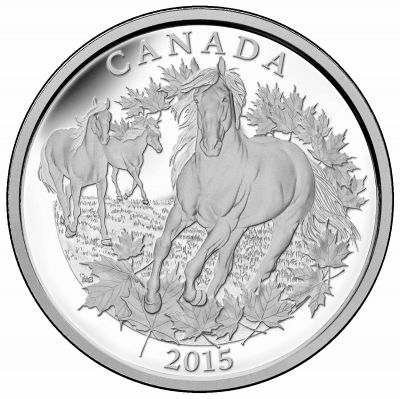
In 2015, for the 350th anniversary of the introduction of the Canadian Horse the Royal Canadian Mint offered a beautiful half-kilogram coin of 99.99 percent pure silver. The special features included:
- Exceptionally large diameter allows for an intricately detailed reverse design to highlight the celebrated beauty of the Canadian horse.
- Only the second coin ever minted on the Royal Canadian Mint’s unique new 85-millimetre blank.
- A low mintage of only 1,000 coins making it highly desirable among collectors.
- Packaged in a black box within a wooden case.
Designed by Canadian artist Michelle Grant, the coin features a portrait of three Canadian horses bounding through a cascade of maple leaves. In the centre, a stallion leaps toward the viewer across a grassy field. A cascade of maple leaves spin clockwise around him. Two other Canadian horses race toward him in the left background. The leaves are engraved in multiple textures to underscore the diverse history of the Little Iron Horse that is so intertwined with Canada’s development. Some historians contend that it was the Canadian horse that gave the North a cavalry advantage in the American Civil War.
For more information, please visit these websites:
- Canadian Horse Breeders Rocky Mountain District
- Canadian Horse Heritage & Preservation Society (CHHAPS)
- Cherry Creek Canadians
- Chevalcanadien.org
- Ebony Breeze Canadians
- Friends of the Nemaiah Valley
- Halcyon Canadians
- Horse Atlantic
- Maison Saint-Gabriel Museum and Historic Site
To read more breed profiles on this site, click here.
This article was originally published in 2015. Some of the details within the content and illustrations may be outdated.
Main photo: Canadian foal Woodmont Celtic, is just hours old as he runs beside Woodmont Tatryana at Woodmont Canadians in Ladysmith, BC. Credit: Jill Livesey



